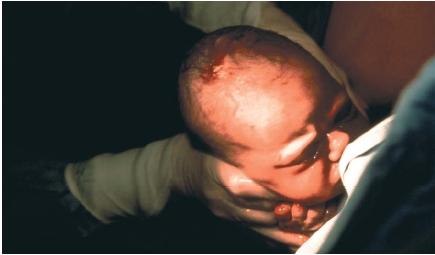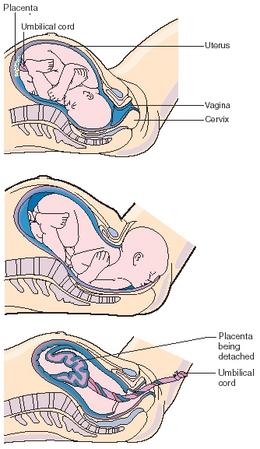Birth

Birth, or parturition (pronounced pahr-chuh-RIH-shuhn), in mammals is the process during which a fully developed fetus emerges from the mother's uterus (or womb) by the force of strong, rhythmic muscle contractions. The birth of live offspring is a reproductive feature shared by mammals, some fishes, and certain invertebrates (such as scorpions), as well as some reptiles and amphibians. Animals that give birth to live offspring are called viviparous (pronounced vie-VIP-uh-rus, meaning "live birth").
In contrast to viviparous animals, other animals such as birds and frogs give birth to eggs; these animals are called oviparous (meaning "egg birth"). Still other animals, such as some fish and reptiles, are ovoviviparous, meaning that the young develop in eggs within the mother's body and hatch either before or immediately after emerging from the mother.
Viviparous animals
In viviparous animals, fertilization of the mother's egg with the father's sperm takes place inside the mother's body. Nutrients are passed from the mother to the developing fetus. In certain mammals, such as humans, this transfer of nutrients occurs through an organ called the placenta, which is formed from the embryo and the mother's uterus.
Words to Know
Amniotic fluid: The fluid in which the fetus is suspended while in the uterus.
Amniotic sac: A thin membrane forming a sac that contains the amniotic fluid.
Cervix: The narrow, bottom end of the uterus; the opening of the uterus.
Fetus: An unborn mammal at the later stages of development. A human embryo is considered a fetus after eight weeks.
Gestation: The period of carrying young in the uterus before birth.
Labor: The strong, rhythmic contractions of the uterus that result in birth.
Placenta: An organ that develops in certain mammals during gestation through which a fetus receives nourishment from the mother.
Umbilical cord: The cord in most mammals that connects the fetus to the placenta.
Uterus (womb): A muscular organ inside the female mammal in which a baby develops.
Viviparous: Animals that give birth to live offspring.
The carrying of young in the uterus is called gestation (pronounced jes-TAY-shun). The length of time between fertilization and birth in viviparous animals is called the gestation period. The gestation period varies, depending on species. In humans, it is about nine months. Elephants have one of the longest gestation periods of all animals, lasting 22 months.
The birth process
The process of birth in humans normally begins at the end of the gestation period with the release of several hormones that stimulate the mother's uterus to contract. Contractions signal the first stage of labor. In order for the fetus to leave the uterus and enter the birth canal (comprised of the cervix and vagina), it must pass all the way through the cervix, the opening of the uterus.
During the first stage of labor, which can last 12 hours or more, the contractions of the uterus move the fetus toward the cervix, causing the cervix to dilate (widen). With dilation, the cervix opens to accommodate the passage of the baby's head. The amniotic sac also usually ruptures, releasing amniotic fluid that streams out of the vagina. (The amniotic sac is a membrane filled with fluid in which the fetus floats while developing in the uterus.)


During the second stage of labor, lasting anywhere from 30 minutes to 2 hours, the mother uses her abdominal muscles to help push the fetus through and out of the birth canal. In a normal delivery, the baby's head appears first (called crowning) and the rest of the body follows. The umbilical cord that connects the fetus to the placenta is tied and cut. The place on the baby's abdomen where the umbilical cord is attached is the navel, or belly button. The baby is now separated from the mother and must breathe air through its own lungs.
In the third stage of labor, usually lasting from a few minutes to a half hour, contractions cause the placenta and fetal membranes to separate from the wall of the uterus and be expelled from the vagina. The placenta and fetal membranes together are called the afterbirth.
[ See also Embryo and embryonic development ; Fertilization ; Hormones ; Reproduction ; Reproductive system ]
also who searches here.
-gia marielle
Many woman who give birth naturally do so while squatting, sitting or leaning forwards over a table etc.
Hospitals tell women to lie on their backs because it's easier for the doctors to observe them that way. Women should take the position that feels best for them and helps the baby to be born easily and healthily.